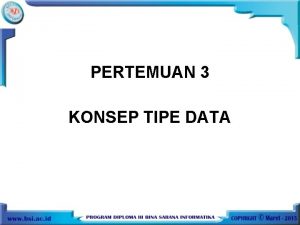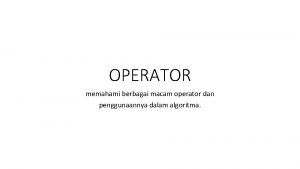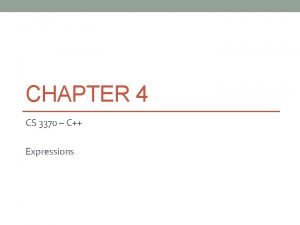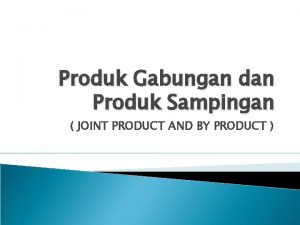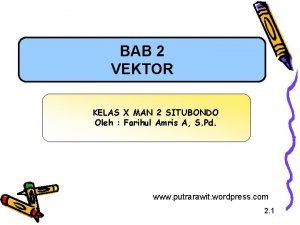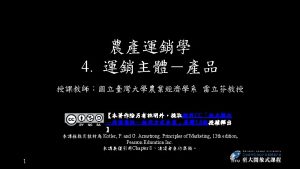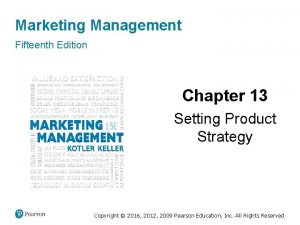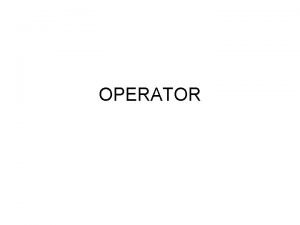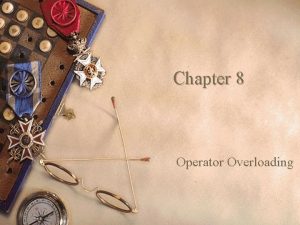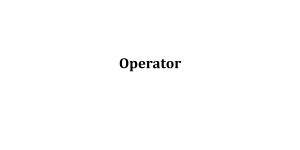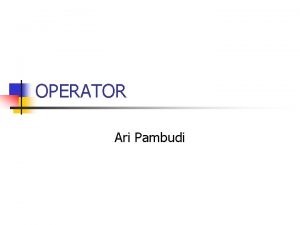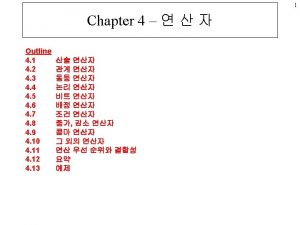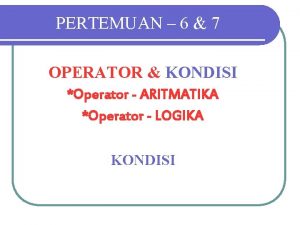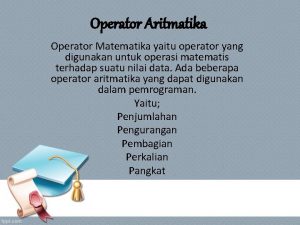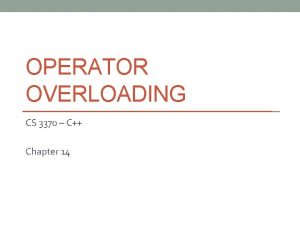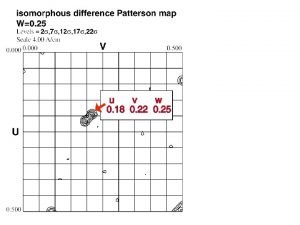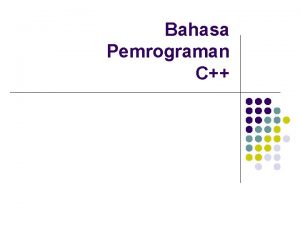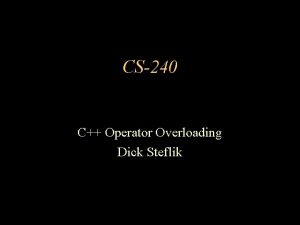Chapter 6 Product Operator Product operator is a



















- Slides: 19

Chapter 6 Product Operator Product operator is a complete and rigorous quantum mechanical description of NMR experiments and is most suited in describing multiple pulse experiments. Wave functions: Describe the state of a system. One can calculate all properties of the system from its wavefunction. Operators: Represents an observable which operate on a function to give a new function. Angular Momentum: A measure of the ability of an object to continue rotational motion. Spin angular momentum I x, Iy, Iz etc. Hamiltonian: The operator of energy if a system. One Hamiltonian to describe a particular interaction. The evolution of a Hamiltonian determines the state of the spins and the signal we detect. The operator of a single spin (Ix, Iy, and Iz): The density operator of a spin -1/2 system: (t) = a(t)Tx + b(t)Iy + c(t)Iz At equilibrium only Iz is non-vanishing. Thus, (t)eq = Iz with c(t) = 1.

Hamiltonian for free precession (During delay time): H = ·Iz, where is the rotational frequency. Hamiltonian of an X-pulse: H = 1·Ix. Similarly, H = 1·Iy is the Hamiltonian of a Y-pulse. Equation of motion of a density operator: (t) = exp(-i. Ht) (0)exp(i. Ht) Example: The effect of X-pulse to the spin in equilibrium. (Considered to be very short so that evolution caan be ignored): H = 1 Ix; (0) = Iz. , Thus, (t) = exp(-i. Ht) (0)exp(i. Ht) = exp(-i 1 tp. Ix)Izexp(i 1 tp. Ix) = Iz Cos 1 tp – Iy Sin 1 tp Standard rotations: exp(-i Ia)(old operator)exp(i Ia) = cos (Old operator) + sin (new operator) Example: exp(-i Ix)Iyexp(i Ix) Old operator = Iy and new operator = Iz Find new operator xp(-i Ix)Iyexp(i Ix) = cos Iy + sin Iz

Example 2: exp(-i Iy){-Iz}exp(i Iy) = -cos Iz - sin Ix Shorthand notation: (tp) = exp(-i 1 tp. Ix) (0) exp(i 1 tp. Ix) For the case where (0) = Iz, Example: Calculate the results of spin echo 90 x 180 x Time: 0 a At time 0: (0) = Iz; b c d At time 0 a: Rotation about x by 90 o : (0) = - Iy At time a b: Free precession (Operator = IZ) (Cosidered as rotation wrt Z-axis) At b c rotation wrt x by 180 o : The second term is not affected Or Thus:

C d: Free precession. Again, consider the two terms separately we got: First term: Second s=term: Collecting together the terms in Ix and Iy we got (cos + sin )Ty + (cos sin - sin cos ) Ix = Iy Or Independent of and The magnetization is refocused. - - 1800 - - refocus the magnetization and is equivalent to -1800 pulse. Product operator for two spins: Cannot be treated by vector model Two pure spin states: I 1 x, I 1 y, I 1 z and I 2 x, I 2 y, I 2 z I 1 x and I 2 x are two absorption mode signals and I 1 y and I 2 y are two dispersion mode signals. These are all observables (Classical vectors)

Coupled two spins: Each spin splits into two spins Anti-phase magnetization: 2 I 1 x. I 2 z, 2 I 1 y. I 2 z, 2 I 1 z. I 2 x, 2 I 1 z. I 2 y (Single quantum coherence) (Not observable) Double quantum coherence: 2 I 1 x. I 2 x, 2 I 1 x. I 2 y, 2 I 1 y. I 2 x, 2 I 1 y. I 2 y (Not directly observable) Zero quantum coherence: I 1 z. I 2 z (Not directly observable) Including an unit vector, E there a total of 16 product operators in a weakly-coupled two-spin system. Understand the operation of these 16 operators is essential to understand multiple NMR expts.

Example 1: Free precession of spin I 1 x of a coupled two-spin system: Hamiltonian: Hfree = 1 I 1 z + 2 I 2 z No effect = cos 1 t. I 1 x + sin 1 t. I 1 y Example 2: The evolution of 2 I 1 x. I 2 z under a 90 o pulse about the y-axis applied to both spins: Hamiltonian: Hfree = 1 I 1 y + 1 I 2 y

Evolution under coupling: Hamiltonian: HJ = 2 J 12 I 1 z. I 2 z Causes inter-conversion of in-phase and anti-phase magnetization according to the Diagram, i. e. in anti and anti according to the rules: Must have one component in the X-Y plane !!!

Useful identify: Spin echo in homonuclear-coupled two spins: Non-selective pulse: Assuming only Ix present at the beginning: Since chemical shift is refocused in spin-echo expt we consider only effect of coupling and 180 o pulse: Coupling: 180 o pulse: No effect on the magnetization if both spins are flipped by 180 o !!! The final results When = 1/4 J Ix completely converts to antiphase 2 Iy. Iz. Used in HSQC experiment.

Inter-conversion of in-phase and anti-phase magnetizations: In Anti: Anti in: Heteronuclear coupling: In this case one can apply the pulse to either spins such as in the sequence a c. Sequence a is similar to that of homonuclear coupling. In sequence b the 180 o pulse apply only to spin 1: During second delay the coupling effect gives: Collecting terms results in only Ix left J-coupling has been refocused (So is sequence c) (No transfer of magnetization or decoupling) 180 X

Coherence order: Raising and lowering operators: I+ = ½(Ix + i. Iy); I- = 1/2 (Ix –i-Iy) Coherence order of I+ is p = +1 and that of I- is p = -1 Ix = ½(I+ + I-); Iy = 1/2 i (I+ - I-) are both mixed states contain order p = +1 and p = -1 For the operator: 2 I 1 x. I 2 x we have: 2 I 1 x. I 2 x = 2 x ½(I 1+ + I 1 -) x ½(I 2+ + I 2 -) = ½(I 1+I 2+ + I 1 -I 2 -) + ½(I 1+I 2 - + I 1 -I 2+) P = +2 P = -2 P=0 The double quantum part, ½(I 1+I 2+ + I 1 -I 2 -) can be rewritten as: (Pure double quantum state) Similar the zero quantum part can be rewritten as: ½(I 1+I 2 - + I 1 -I 2+) = ½ (2 I 1 x. I 2 x – 2 I 1 y. I 2 y) (Pure zero quantum state)

Multiple Quantum Coherence: Active spins: Spins that contains transverse components, Ix or Iy. Passive spins: Spins that contain only the longitudinal component, Iz. Evolution of Multiple Quantum Coherence: Chemical shift evolution: Analogous to that of Ix and Iy except that it evolves with frequency of 1 + 2 for p = ± 2 and 1 - 2 for p = 0

Coupling:







 String termasuk tipe data sederhana
String termasuk tipe data sederhana Pada tipe data boolean, berlaku operator-operator :
Pada tipe data boolean, berlaku operator-operator : Logical operators priority in c
Logical operators priority in c Binary and unary operators
Binary and unary operators New product development and product life cycle strategies
New product development and product life cycle strategies Produk gabungan
Produk gabungan Relationship between total average and marginal product
Relationship between total average and marginal product Product line vs product mix
Product line vs product mix Core product actual product
Core product actual product Dot cross product
Dot cross product Industry/target market feasibility analysis example
Industry/target market feasibility analysis example Product overview definition
Product overview definition Sifat perkalian cross vektor
Sifat perkalian cross vektor Core customer value
Core customer value Product range vs product mix
Product range vs product mix Perkalian silang
Perkalian silang Distinguish between gdp and gnp
Distinguish between gdp and gnp Chapter 4 product and service design pdf
Chapter 4 product and service design pdf Seven steps of product development
Seven steps of product development Chapter 13 setting product strategy ppt
Chapter 13 setting product strategy ppt
